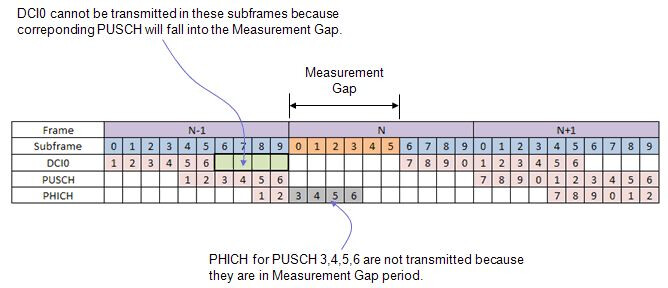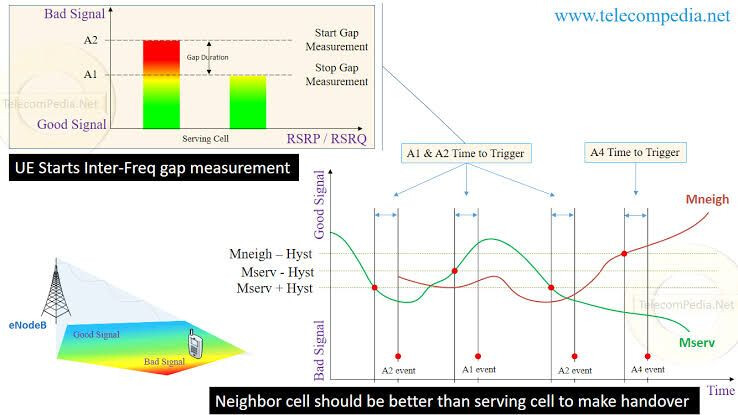[What, Why, How, Challenges and Optimizing]
![]() What is a Measurement Gap? to measure neighboring cells on different frequencies or different technologies “IRAT” (e.g., 3G/2G).
What is a Measurement Gap? to measure neighboring cells on different frequencies or different technologies “IRAT” (e.g., 3G/2G).
measurement gaps; it’s a predefined interval where the user equipment pauses transmission/receiving on its current frequency to measure neighbors.
![]() Why Do We Need Measurement Gaps?
Why Do We Need Measurement Gaps?
![]() Single Transceiver Limitation: Most UEs lack dual RF chains (it’s costly). Measurement gaps allow them to temporarily switch frequencies without disrupting ongoing sessions.
Single Transceiver Limitation: Most UEs lack dual RF chains (it’s costly). Measurement gaps allow them to temporarily switch frequencies without disrupting ongoing sessions.
![]() Even have more chains in certain scenarios, like measuring very distant frequency bands that require different configurations.
Even have more chains in certain scenarios, like measuring very distant frequency bands that require different configurations.
![]() Handover Precision: Accurate neighbor cell measurements (RSRP/RSRQ) are vital for triggering events like A3 (neighbor becomes offset better than serving) or A4 (neighbor becomes better than threshold).
Handover Precision: Accurate neighbor cell measurements (RSRP/RSRQ) are vital for triggering events like A3 (neighbor becomes offset better than serving) or A4 (neighbor becomes better than threshold).
![]() How Are Measurement Gaps Configured in 4G?
How Are Measurement Gaps Configured in 4G?
![]() In LTE, the eNodeB controls measurement gaps via RRC Connection Reconfiguration messages. The configuration includes:
In LTE, the eNodeB controls measurement gaps via RRC Connection Reconfiguration messages. The configuration includes:
![]() Gap Duration: Fixed at 6 ms. This gives the UE enough time to retune its RF chain, measure neighboring cells, and return to the serving frequency.
Gap Duration: Fixed at 6 ms. This gives the UE enough time to retune its RF chain, measure neighboring cells, and return to the serving frequency.
![]() Gap Pattern ID: Defines the periodicity of gaps.
Gap Pattern ID: Defines the periodicity of gaps.
- Pattern 0: 40 ms periodicity (6ms gap every 40ms).
- Pattern 1: 80 ms periodicity (6ms gap every 80ms).
It depends on urban or rural area and other reasons.
![]() Measurement Purpose: Specifies whether gaps are for inter frequency LTE or inter RAT measurements.
Measurement Purpose: Specifies whether gaps are for inter frequency LTE or inter RAT measurements.
![]() Some Challenges in MG Implementation…
Some Challenges in MG Implementation…
![]() Throughput Trade offs: Gaps reduce scheduling opportunities, impacting user throughput. A 6ms gap every 40ms reduces scheduling opportunities by ~15%. But real world impact varies with traffic patterns and network load.
Throughput Trade offs: Gaps reduce scheduling opportunities, impacting user throughput. A 6ms gap every 40ms reduces scheduling opportunities by ~15%. But real world impact varies with traffic patterns and network load.
![]() Scheduling Complexity: eNBs must avoid scheduling critical data (e.g., HARQ) during gaps. Misalignment causes retransmissions and latency spikes.
Scheduling Complexity: eNBs must avoid scheduling critical data (e.g., HARQ) during gaps. Misalignment causes retransmissions and latency spikes.
![]() Parameter Tuning: Aggressive gaps (short periodicity) improve mobility but hurt throughput. Conservative gaps risk missed handovers.
Parameter Tuning: Aggressive gaps (short periodicity) improve mobility but hurt throughput. Conservative gaps risk missed handovers.
![]() Optimization Strategies…
Optimization Strategies…
![]() Gap Pattern Selection: Use MGRP (Measurement Gap Repetition Period) tailored to deployment density. Urban areas with small cells may tolerate shorter gaps “40ms” vs rural macro cells.
Gap Pattern Selection: Use MGRP (Measurement Gap Repetition Period) tailored to deployment density. Urban areas with small cells may tolerate shorter gaps “40ms” vs rural macro cells.
![]() Event Driven Triggers: Configure events (e.g., A3/A4/A5) with hysteresis and time to trigger to minimize unnecessary gaps.
Event Driven Triggers: Configure events (e.g., A3/A4/A5) with hysteresis and time to trigger to minimize unnecessary gaps.
![]() KPI Monitoring: Track Handover Success Rate, Radio Link Failure and Throughput Degradation to balance mobility and capacity.
KPI Monitoring: Track Handover Success Rate, Radio Link Failure and Throughput Degradation to balance mobility and capacity.
![]() Carrier Aggregation (CA): to avoid gaps. UEs with CA capability can measure secondary cells (SCells) without gaps.
Carrier Aggregation (CA): to avoid gaps. UEs with CA capability can measure secondary cells (SCells) without gaps.
In some scenarios still require gaps, particularly for IRAT or measuring candidate SCell that is on a different frequency.
![]() Self Organizing Network (SON): automate gap configuration based on real time KPIs like handover success rates.
Self Organizing Network (SON): automate gap configuration based on real time KPIs like handover success rates.
LinkedIn: ![]()


